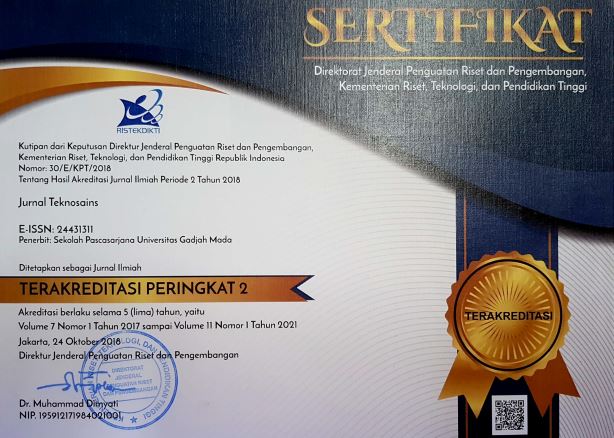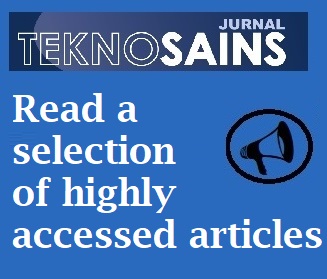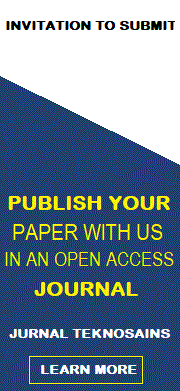Analisis potensi penerapan teknologi produksi bersih pada c-maxi alloycast, Yogyakarta
Dewi Masri(1*), Wagiman Wagiman(2), Bertha Maya Sopha(3)
(1) Universitas Gadjah Mada
(2) Universitas Gadjah Mada
(3) Universitas Gadjah Mada
(*) Corresponding Author
Abstract
CV C-Maxi Alloycast is an industry engaged in the manufacture of household appliances (pans) made of aluminum which is located in Yogyakarta. The aim of the study was to identify the potential application of clean production principles in CV C-Maxi Alloycast. The methods used were production process mapping, waste analysis through liquid waste testing and potential analysis of clean production principles. The results obtained for the production process were smelting aluminum and scrap, pouring molten metal into molds, lifting molds and providing coolant, lifting castings, turning, filing, quality control, storage and distribution. Based on the laboratory test, the characteristics of the liquid waste produced by the CV C-Maxi Alloycast were pH 8.9; COD 52.1 mg/L; BOD 21.4 mg/L; TSS 6660 mg/L; Fe 4,2440 mg/L; Cu 0.0130 mg/L; and Zn 0.0893 mg/L. All parameters indicate that the value meets the quality standard, but the TSS content did not meet the NAB (Threshold Value) which refers to the Regulation of the Minister of the Environment of the Republic of Indonesia No. 5 of 2014 and the Regulation of the Special Region of Yogyakarta (DIY) No. 7 of 2016. Clean production opportunities were: good housekeeping, application of 3R (Reduce, Reuse, Recycle) on solid waste, construction of B3 Waste TPS and capacity building of human resources. Environmental performance had increased based on the Green Industry Standard (SIH) from level 1 to level 2 with a value of 53% to 65% with the implementation of clean production. The economic performance of implementing clean production gains a profit of Rp. 77,412,000,-/year, then the second alternative, namely recycling aluminum scrap is an economical alternative to clean technology with a 5-year NPV value of Rp. 37,853,056,558,- Implementing clean production can have a positive impact on the environment and the economy.
Keywords
Full Text:
PDFReferences
Alves, Barbara., Dungan. R.S., Carnin, R.L., Pinto, Carvalho., dan Galves, Rosa. (2014) ‘Metals in Waste Foundry Sands and an Evaluation of Their Leaching and Transport to Groundwater’, Water Air Soil Pollution, 225(5):1-11.
Acharya, S.G., Kikani, P., dan Acharya, G.D. (2015) ‘Greening of Foundry Industries for Cleaner Production’, International Journal of Emerging Technologies and Aplications in Engineering, ISSN: 0974-3588: 78-81.
Asidu, L.A.D., Hasbi, M., dan Aksar, P. (2016) ‘Pemanfaatan Minyak Oli Bekas Sebagai Bahan Bakar Alternatif dengan Pencampuran Minyak Pirolisis’, Enthalpy-Jurnal Mahasiswa Teknik Mesin, 2(2): 1-7.
Bhattacharya, S.C., Albina, D.O., dan Salam, P.A. (2002) ‘Emission Factors of Wood and Charcoal-Fired Cookstoves’, Biomass and Bioenergi, 23 (6): 453-469.
Curran, M.A. (2013) ‘Life Cycle Assessment: A Review of The Methodology and Its Application to Sustainability’, Curren Opinion In Chemical Engineering, 2(3): 273-277.
Effendi, H. (2003) ‘Telaah Kualitas Air Bagi Pengelolaan Sumber Daya dan Lingkungan Perairan’, Kanisius Press, Yogyakarta.
Generousdi, Rodesri M. (2005) ‘Penerapan Teknologi Produksi Bersih pada Industri Elektroplating’, Jurnal Teknik Mesin, 2 (1): 11-18.
Haryanto, Agus., dan Triyono, Sugeng. (2012) ‘Studi Emisi Masak Rumah Tangga’, Agritech, 32 (4): 425-431.
Hidayat, A.R., dan Basyiron. (2020) ‘Pengaruh Jenis Oli Bekas Sebagai Bahan Bakar Kompor Pengecoran Logam terhadap Waktu Konsumsi dan Suhu Maksimal pada Pembakaran’, Jurnal Dinamika Vokasional Teknik Mesin, 5 (2): 103-108.
Indriyati. (2008) ‘Strategi Teknologi Produksi Bersih Tata Kelola Yang Apik (GHK)’, ISSN 1441-318X: 15-19.
Kemenperin. (2016) ‘Peraturan Menteri Perindustrian Republik Indonesia Nomor
18/M-IND/PER/3/2016 tentang Penghargaan Industri Hijau’.
KemenLH. (2002) ‘Prinsip-prinsip dalam Produksi Bersih’.
KemenLH RI. (2014) ‘Kementerian Lingkungan Hidup Republik Indonesia No.5 Tahun 2014 tentang Baku Mutu Limbah Cair Industri’.
Masri, Dewi. (2018) ‘Identifikasi Potensi Bahaya, Analisis Risiko dan Teknik Keselamatan dan Kesehatan Kerja di C-Maxi Alloycast’, Skripsi, Universitas Islam Indonesia.
Musa, D.M., Ujih, U.O., dan Azare, I.M. (2016) ‘Effect Fuel Wood Exploitation on The Environtment: A Case Study of Nasarawa Local Government Area, Nasarawa State, Nigeria’, Dutse Journal of Pure and Applied Science, 2(1): 195-201.
Moertinah S. (2008) ‘Peluang-Peluang Produksi Bersih pada Industri Tekstil Finishing Bleaching (Studi Kasus Pabrik Tekstil Finishing Bleaching PT.Damaitek Semarang)’, Tesis, Semarang: Universitas Diponegoro.
Murphy, Sheila. (2007) ‘General Information on Solids’, USGS Water Monitoring, http://bcn.boulder.co.us/basin/data/BACT/info/TSS.html. 15 Juni 2021 (12.30).
Nobrega, J.H.C., Pio, P.G.C., Fernandes, G.L., Botelho, S.T., Araujo, T.C., Anholon, R., Ordonez, R.E.C., Rampasso, I.S., Leal Filho, W. dan Quelhas, O.L.G. (2019) ‘Sustainability in Manufacturing Processes: Practices Performed in Metal Forming, Casting, Heat Treatment, Welding and Electrostatic Painting’, The International Journal Of Sustainable Development and World Ecology, 26(8): 684-697.
Nurdalia, Ida. (2006) ‘Kajian dan Analisis Peluang Penerapan Produksi Bersih pada Usaha Kecil Batik Cap (Studi kasus pada tiga usaha indudstri kecil batik cap di Pekalongan)’, Tesis, Universitas Diponegoro.
Perda DIY. (2016) ‘Peraturan Daerah Istimewa Yogyakarta No.7 Tahun 2016 tentang Baku Mutu Air Limbah.
Pratama, Annasrudin., Basyiron., Atmojo, Y.W., Ramadhan, G.W., dan Hidayat, A.R. (2020) ‘Rancang Bangun Kompor (Burner) Berbahan Bakar Oli Bekas’, Mekanika, 19 (2): 1-9.
Raharjo, W.P. (2007) ‘Pemanfaatan Oli Bekas Sebagai Salah Satu Alternatif Solusi Untuk Mengurangi Kebutuhan Minyak Bakar’, Jurnal Mekanika, 3(1):23-25.
Simanjuntak, D.S. (2019) ‘Penurunan Kadar TSS pada Limbah Cair Tahu Menggunakan Rumput Vetiver (Vetiveria Zizanioides L), Regional Development Industry & Health Sciences’, Technology and Art of Life, 2(1): 70-73.
Sirait, A.T., Noon, Erliza., dan Ismayana, Andes. (2018) ‘Penerapan Produksi Bersih untuk Meningkatkan Efisiensi Proses Pelapisan Logam’, Journal of Natural Resources and Environmental Management, 9(3):700-709.
Sithole, Cindy., Nyembwe, Kasongo., dan Olubambi, Peter. (2019) ‘Process Knowledge for Improving Quality in Sand Casting Foundries: A Literature Review’, Elsevier: 356–360.
Zheng, Jun., Huang, Binbin., dan Zhou, Xingjian. (2018) ‘A Low Carbon Process Design Method of Sand Casting Based on Process Design Parameters’, Journal of Cleaner Production, 197(1): 1408-1422.
Zhu, F., Yan, F., Wang, Y., Zhang, Z., Li C., dan Dong Y. (2018) ‘Inhibition of PM 2.5 Emission from Combustion of Waste Materials’, American Chemical Society, 32(10): 1-3.
Article Metrics
Refbacks
- There are currently no refbacks.
Copyright (c) 2022 Dewi Masri dkk.

This work is licensed under a Creative Commons Attribution-ShareAlike 4.0 International License.
Copyright © 2024 Jurnal Teknosains Submit an Article Tracking Your Submission
Editorial Policies Publishing System Copyright Notice Site Map Journal History Visitor Statistics Abstracting & Indexing









